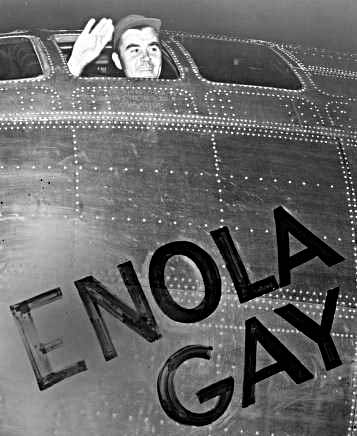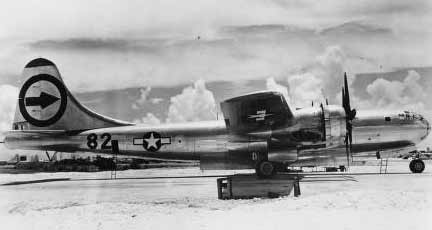Colonel Paul W. Tibbets waving from the cockpit of the Enola Gay before taking off on August 6, 1945. U.S. Air Force photo.
In short

On August 6, 1945, the Enola Gay B-29 bomber flew over Hiroshima, Japan, and dropped the world’s first atomic bomb. Three days later, the U.S. dropped another bomb on Nagasaki. The explosions annihilated tens of thousands of people and devastated the cities. Stunned, the Japanese surrendered and World War II ended.
The crew that dropped the bombs had trained in Utah’s West Desert.
More of the Story
It was a top-secret mission. Nobody was to know exactly why the 509th Composite Group had come to Wendover Air Base to train.
Several bombardment groups had already come through Wendover to train on B-17s, B-24s, and B-29s. These crews bombed mockups of battleships and cities built in the desert. Fighter pilots also practiced here.
The Enola Gay (Boeing B-29 Superfortress) at the Marianas Islands. U.S. Air Force photo.

But in December 1944, the focus was on the 509th. 1,500 men had come to train and work toward a mission they didn’t understand. The technicians working on the components of the bombs didn’t understand. For much of the time, the only person in the 509th Composite Group who did understand the entire mission was commanding officer Colonel Paul Tibbets. Tibbets had the responsibility to oversee the training, logistics, and bombing.
The crews practiced dropping dummy bombs on Utah’s desert lands until they were ready.
Then, on August 6, Tibbets piloted the Enola Gay in its flight over Hiroshima. The bomb destroyed 4.7 square miles of the city and killed 70,000-80,000 people instantly. 100,000 or more died within the following months from radiation, and others later developed cancers.
Three days later, another crew dropped an atom bomb on Nagasaki—repeating the horror.
Japan formally surrendered on August 14, 1945.
Keep Exploring
Return to the Events page here.
Return to the I love Utah History Home Page here.